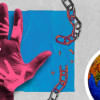An uncompassionate act on a compassionate ground

The distressing image of Ali Azam, president of the Boali union unit of the BNP in Kaliakair upazila of Gazipur district, leading the funeral prayer of his mother in fetters and handcuffs has exposed the emptiness of so-called compassion in our policing and prison system. It is well known that parole is granted only on the ground of compassion to anyone under custody, irrespective of conviction or even if they are under trial. But Ali Azam's case has proven that such a compassionate act can also become egregiously uncompassionate behaviour.
Though this excruciating image has drawn widespread condemnation within the country, the government seems to be unmoved. Neither has any action been taken against those involved in such inhumane treatment of a detainee, nor has any investigation been ordered, despite a rare intervention by the National Human Rights Commission (NHRC) in this regard. The only voice heard was that of Information Minister Hasan Mahmud, who said that taking off Azam's fetters and handcuffs during the prayer would have been better. Lack of any administrative action against the officials involved indicates there was no contrition or remorse within the government over such degrading and cruel behaviour.
Press reports quoted Gazipur jail superintendent Mohammad Bazlur Rashid as saying that police acted as per the law. He said, "According to the Jail Code, any accused must be bound with handcuffs and fetters even if they are released for a while on parole." The code referred to by the jail superintendent is the Prisons Act, 1894, from which this degrading provision has long been stricken off in India and Pakistan, the two other parts of the then British India.
In India, the decision to bind an accused is no longer at the discretion of the prison authority or police, but of the judiciary instead. The Supreme Court of India, in its directives, made it a requirement for agencies of law enforcement to ask the court's permission before handcuffing a person.
In 1980, in Prem Shankar Shukla vs Delhi Administration, the court examined the rationale behind fetters and held that handcuffing is prima facie inhuman and hence unreasonable as well as arbitrary in the absence of fair procedure and objective monitoring. The court observed that when there is no compulsive need to fetter a person's limbs, it is sadistic, capricious, despotic, and demoralising to humble a man by manacling him. Thus, the Indian court concluded that handcuffs must be the last refuge and not a routine regimen. Furthermore, the court held that the escorting officer must show reasons to the presiding judge as to why the accused should be handcuffed and get the judge's approval before going through with the act.

A February 2022 report by The Wire, on the Delhi High Court's refusal to permit Delhi police to produce two persons accused in the Delhi riots conspiracy case – former student leader Umar Khalid and rights activist Khalid Saifi – in handcuffs before the trial court, cited another judgement in which the Indian Supreme Court had declared that its directives were binding rules. In 1995, the Indian SC considered a letter written by journalist Kuldip Nayar recounting the ordeal of detainees under the Terrorist and Disruptive Activities (Prevention) Act (TADA) in Guwahati at a hospital, where they were handcuffed to their beds despite the room being barred and several policemen guarding the room. The court concluded by saying, "We declare, direct and lay down as a rule that handcuffs or other fetters shall not be forced on a prisoner – convicted or under-trial – while lodged in a jail anywhere in the country or while transporting or in transit from one jail to another or from jail to court and back."
In Pakistan, it happened a decade later.
The Pakistan Supreme Court, in 2006, barred police from putting fetters on prisoners in jails without seeking the approval of the district and sessions judges on the recommendation of the inspector-general of prisons. According to Dawn newspaper, a bench comprising Chief Justice Iftikhar Muhammad Chaudhry and Justice Mohammad Nawaz Abbasi, in a suo moto notice following a complaint from a prisoner, also asked sessions judges that before granting such approvals, they should scrutinise whether the prisoner in question was involved in a heinous crime and could be termed a hardened criminal. The prisoner who had complained to the court had stated that he was put into fetters whenever he was taken for court proceedings, though the shackles were removed when he was confined inside the jail.
In Bangladesh, a High Court bench, in 2017, had issued an order restricting the use of bars and fetters only on court premises. It, too, was a suo moto directive, as four accused persons were produced before the bench in fetters. The court, however, did not ban its use altogether or during prisoners' transportation between prison and the courts.
The jail code cited by the Gazipur jail superintendent allows him and his superior authority, the Inspector General of Prisons, to consider whether it is necessary (with reference either to the state of the prison or the character of the prisoners) for the safe custody of any prisoners that they should be confined in irons. But the words "Prisoners under Sentence" in 57(1) of the Prisons Act, 1894, also suggests under-trial prisoners or suspects in custody should not be forced into fetters.
It has been reported by the media that, following the two condemned militants' escape from a crowded Dhaka court, police have resorted to using fetters to restrain dangerous criminals. Justifying the imposition of fetters on Ali Azam, police have argued that he's been implicated in a case involving explosives.
This argument raises another issue of the unethical but widespread practice of so-called gayebi mamla (fictitious or fabricated cases) filed by police or by coerced or misled complainants. Media reports have found that the person who filed the case against Ali Azam was kept in the dark about the complaint and knew no information about the alleged crime. We need to bring an end to all these practices.
If the rest of the sub-continent can ditch the inhumane colonial legacy discussed above, why can't Bangladesh?
Kamal Ahmed is an independent journalist. His Twitter handle is @ahmedka1

 For all latest news, follow The Daily Star's Google News channel.
For all latest news, follow The Daily Star's Google News channel. 






Comments